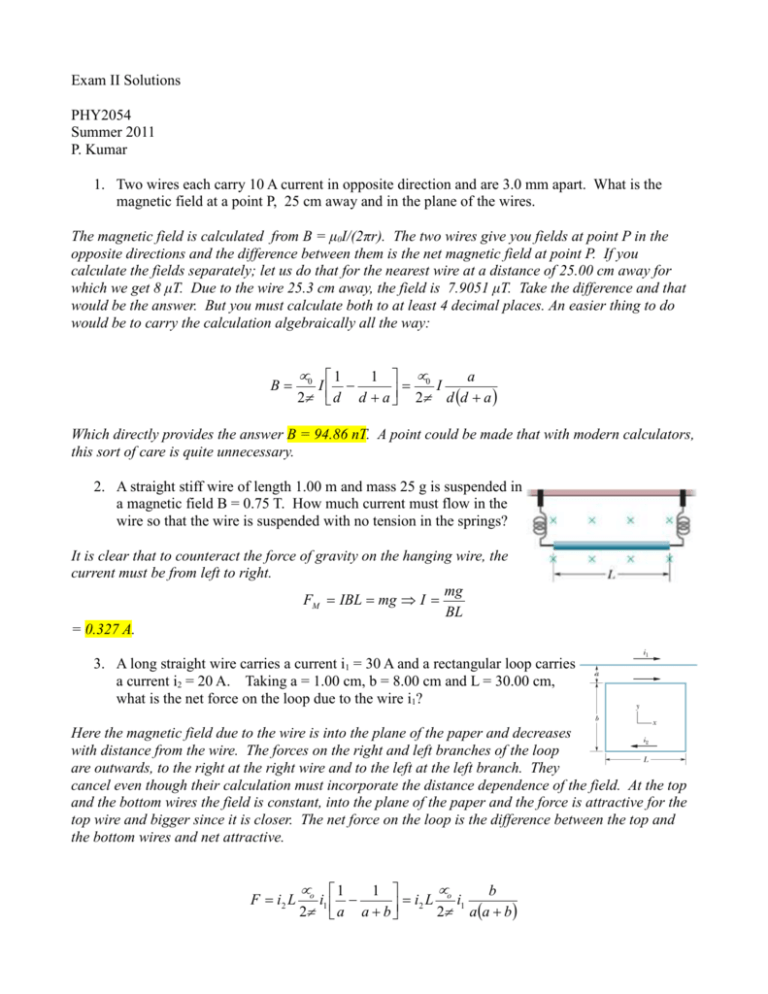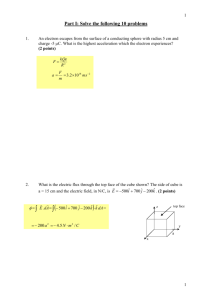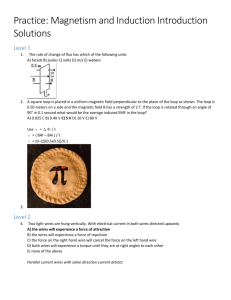Solutions
advertisement

Exam II Solutions PHY2054 Summer 2011 P. Kumar 1. Two wires each carry 10 A current in opposite direction and are 3.0 mm apart. What is the magnetic field at a point P, 25 cm away and in the plane of the wires. The magnetic field is calculated from B = µ0I/(2πr). The two wires give you fields at point P in the opposite directions and the difference between them is the net magnetic field at point P. If you calculate the fields separately; let us do that for the nearest wire at a distance of 25.00 cm away for which we get 8 µT. Due to the wire 25.3 cm away, the field is 7.9051 µT. Take the difference and that would be the answer. But you must calculate both to at least 4 decimal places. An easier thing to do would be to carry the calculation algebraically all the way: B= µ0 2π 1 µ0 a 1 I − = I d d + a 2π d (d + a ) Which directly provides the answer B = 94.86 nT. A point could be made that with modern calculators, this sort of care is quite unnecessary. 2. A straight stiff wire of length 1.00 m and mass 25 g is suspended in a magnetic field B = 0.75 T. How much current must flow in the wire so that the wire is suspended with no tension in the springs? It is clear that to counteract the force of gravity on the hanging wire, the current must be from left to right. mg FM = IBL = mg ⇒ I = BL = 0.327 A. 3. A long straight wire carries a current i1 = 30 A and a rectangular loop carries a current i2 = 20 A. Taking a = 1.00 cm, b = 8.00 cm and L = 30.00 cm, what is the net force on the loop due to the wire i1? Here the magnetic field due to the wire is into the plane of the paper and decreases with distance from the wire. The forces on the right and left branches of the loop are outwards, to the right at the right wire and to the left at the left branch. They cancel even though their calculation must incorporate the distance dependence of the field. At the top and the bottom wires the field is constant, into the plane of the paper and the force is attractive for the top wire and bigger since it is closer. The net force on the loop is the difference between the top and the bottom wires and net attractive. F = i2 L µo 2π µ 1 b 1 i1 − = i2 L o i1 2π a (a + b ) a a + b = 3.2 mN. 4. Two long straight wires have been held against a plastic cylinder of radius 20 cm. Wire 1 carries a current i1 = 60 mA out of the page and it is fixed in place at the left side of the cylinder. Wire 2 carries current i2 = 40 mA out of the page and can be moved around the cylinder. At what angle θ2 (in positive degrees) should wire 2 be so that the net magnetic field at the origin is 30 nT? The field at the cylinder center due to wire 1 is B1 = ŷ µoI/2πr = ŷ 60 nT. The field due to wire 2 has magnitude B2 = 40 nT directed downwards perpendicular to the line joining wire 2 with the center of the cylinder, at an angle θ2 from the -y axis. The total field is B = B1 +B2. Here |B|2 = B12+ B22+2B1B2cos(π- θ2) or B12 + B22 − B 2 cos θ 2 = 2 B1 B2 For B = 30 nT, θ2 = 26.38°. 5. A loop antenna of area 2.00 cm2 and resistance 5.21 µΩ is perpendicular to a uniform magnetic field of magnitude 17.0 µT. The field magnitude drops to zero in 2.96 ms. How much thermal energy (in nJ) is produced in the loop by the change in field? Power P = ε 2/R and the energy deposited is U = P∆t = (A ∆B)2/R∆t = 0.75nJ. 6. Two straight conducting rails form a right angle. A conducting bar in contact with the rails starts at the vertex at time t = 0 and moves with a constant velocity of v m/s along them. A magnetic field with B = 0.350 T is directed out of the page. If the emf generated in the triangular loop at time t = 3s is 56.8 V, what is v (in m/s)? The question asks you to calculate the area of the right angled triangle as the bar moves forward. The area is (vt)2 (One way to see this is that the hypotenuse is 2vt). Therefore the emf ε = 2Bv2t or 56.8 = 2x0.35xv2 x3, solve for v = 5.2 m/s. 7. In an oscillating LC circuit, L = 3.00 mH and C = 2.70 µF. At t = 0 the charge on the capacitor is zero and the current is 2.00 A. What is the maximum charge (in mC) that will appear on the capacitor? The charge on capacitor must be Q = Qo sinωt and therefore I = dQ/dt = ω Qo cosωt i.e. ω Qo = 2. Since ω = 1/√(LC) it follows that Qo = 0.18 mC. 8. Unpolarized light is sent into the system of three polarizing sheets, where the polarizing directions of the first and third sheets are at angles θ1 = 30° (counterclockwise) and θ3 = 30° (clockwise) with respect to the y axis. What fraction of the initial light intensity emerges from the system if the middle sheet has its axis lined along the x-axis? I= 1 cos 2 120 cos 2 60 2 It is always the angular difference with respect to the last polarizer. The answer is 1/32. 9. In the problem above, put the optical axis of the middle sheet at some arbitrary angle θ, measured clockwise from the y axis. At what angle θ (in degrees) is the emergent light of minimum intensity? If the middle polarizer is at ninety degrees to the first one, all light is stopped before it even gets to the third polarizer. 10. A metal rod is forced to move with constant velocity along two parallel metal rails, which are connected with a strip of metal (see figure). A magnetic field of 0.5 T points out of the page. The separation between the rails is L = 30 cm, the rod has resistance 40Ω, and velocity 70cm/s. What force ( in mN) must be applied to the rod to keep it moving at the constant velocity? This problem is a test of whether you believe in Newton's laws. The rod's motion creates an emf and a current I = BLv/R. Lenz's law says that the current is bottom to top in bar and clockwise in the loop. Therefore there will be a force on the bar to the right F = ILB = (BL)2 v/R = 0.394 mN. You must apply a force of that magnitude directed to left which will let the bar move with a constant velocity. 11. Of the three chief kinds of magnetic materials (diamagnetic [a], paramagnetic [b], and ferromagnetic [c]) which ones are used to make compass needles? Both diamagnets and paramagnets acquire magnetization only in the presence of a magnetic field. Compass needles operate by themselves, hence only ferromagnets can be used in a compass needle. 12. If the electric field in a plane electromagnetic wave is given by E(x, t) = 8500 sin(33x − ωt), in SI units, the frequency of the wave (in GHz) is: It would seem that given ω in the expression for electric field, there is no answer to this question. Not so. it is an electromagnetic wave traveling with speed c = 3x108 m/s. We see that the wave number is 33. The answer sought is in GHz which is ω/2π = ck/ 2π = 1.576 x 109 Hz. 13. A wire of length L carries a current i. If the wire is bent into a circular coil of N turns and placed into a uniform magnetic field B, what is the magnitude of the maximum possible torque on the loop? The maximum torque T = BiAN. Here A = π r2 and 2πrN = L. Eliminating r leads to T = L2iB/4πN. 14. A ray is incident on one face of a triangular glass prism in air. The angle of incidence θ is chosen so that the emerging ray also makes the same angle θ with the normal to the other face, as shown. If the apex angle of the prism is φ = 72±, and the index of refraction of the prism is n = 1.60, what is θ (in degrees)? The angle θ being the same, the angles of refractions must also be the same and since the sum of the angles of refraction is equal to the vertex angle 72, each must be 36. At either interface therefore sinθ = 1.6 sin 36 or θ = 70˚. The general expression for a solution is sin θ = n sin φ/2 15. In a uniform magnetic field, an electron undergoes a circular motion with a kinetic energy of 6.4x10-17J. The radius of the orbit is 23.0 mm. What is the magnetic field in T? Recall that in a cyclotron motion, r = mv/qB or r = √(2mK)/qB. Alternatively B = √(2mK)/qr = 2.93 mT.






